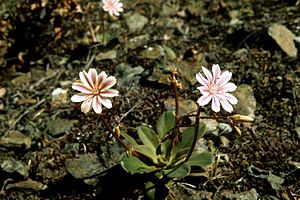Bitterroot
| Bitterroot | ||||||||||||
|---|---|---|---|---|---|---|---|---|---|---|---|---|

Common bitterwort ( Lewisia cotyledon ) |
||||||||||||
| Systematics | ||||||||||||
|
||||||||||||
| Scientific name | ||||||||||||
| Lewisia | ||||||||||||
| Pursh |
The Bitterwurz ( Lewisia ) are a plant kind from the family of Montiaceae . It was named in honor of Meriwether Lewis , an explorer of the American West.
description
They are perennial, deciduous or evergreen herbaceous plants . They form a succulent caudex with a long tap root or, rarely, a bulbous root. The leaves are spirally distributed in a rosette , either basal or on a stem . They are fleshy, entire, toothed or curled, gradually narrowing in a wedge shape at the base and sessile or tapering into a short, wide petiole that more or less surrounds the stem.
The axially formed inflorescences are panicles or paniculate racemes , rarely single flowers . Their stems rarely have alternate, opposite or whorled leaves, but are usually leafless. At each blooming node there are two (to nine) somewhat unequal bracts . The sepals stand in pairs and are small or in pairs to ninth and are then large and petal-like. The four to 19 petals are thin, often of different sizes and white, yellow, pink or magenta, often with darker nerves or stripes. The 4 to 50 stamens are free or are more or less fused with each other and / or with the petals. The spherical to ovoid ovary wears a long pen with three to eight scars rays . The capsule fruit contains few or many, brown or black seeds .
Systematics and distribution
The distribution area of the genus containing 17 species is limited to the mountainous west of North America and extends from Alaska and Canada via the USA ( Rocky Mountains , Cascade Range , Sierra Nevada ) to Mexico ( Baja California ). The plants usually grow in small, scattered populations in ravines , on alpine plateaus , on rocks or gravel surfaces . Some species are common and widespread, but others are very rare and found only very locally. The main distribution center, also for the rare species, is the state of California .
Sections
The genre is divided into the following sections.
[1] Section Lewisia : Plants with falling leaves, segmented flower stalks, two to nine sepals that are dry when they are ripe, and flowers that fall as a whole.
[2] Brachycalyx B.Mathew : Plants with sloping leaves, the inflorescence of which consists only of a single sessile flower, the bracts and sepals of which touch.
[3] Section Erocallis B.Mathew : Plants with sloping leaves and a spherical tuber and well-developed leaves on the inflorescence stalk in three-whorls.
[4] Section Oppositifolia B.Mathew : Plants with sloping leaves, long and slender flower stalks and well-developed, opposite leaves on the inflorescence stem.
[5] Section Pygmeae B.Mathew : Plants with sloping, mostly very narrow leaves and slightly branched inflorescences.
[6] Section Cotyledon J.E.Hohn ex B.Mathew : Plants with perennial, evergreen and mostly wide leaves and high, richly branched inflorescences.
species
- Lewisia brachycalyx Engelm. ex A.Gray [2]: USA ( California , Arizona , Utah ), Mexico ( Baja California )
- Lewisia cantelovii J.T. Howell [6]: USA (California, Nevada )
-
Lewisia columbiana ( JTHowell ex A.Gray ) BLRob. [6]
- Lewisia columbiana var. Columbiana : Canada ( British Columbia ), United States ( Washington , Oregon )
- Lewisia columbiana var. Rupicola ( English ) CLHitchc. : Canada (British Columbia), USA (Washington, Oregon)
- Lewisia columbiana var. Wallowensis C.L. Hitchc . : USA ( Idaho , Montana , Oregon)
- Lewisia congdonii ( Rydb. ) S.Clay [6]: USA (California)
- Common bitterwort , also known as "porcelain rose" ( Lewisia cotyledon ( S.Watson ) BLRob. ) [6]
- Lewisia disepala Rydb. [1]: USA (California)
-
Lewisia kelloggii K.Brandegee [2]
- Lewisia kelloggii var. Hutchinsonii Dempster : USA (California)
- Lewisia kelloggii var. Kelloggii : USA (California, Idaho)
- Lewisia leeana ( Porter ) BLRob. [6]: USA (California, Oregon)
- Lewisia longipetala ( Piper ) S.Clay [5]: USA (California)
- Lewisia maguirei A.H. Holmgren [1]: USA (Nevada)
- Lewisia nevadensis ( A. Gray ) BLRob. [5]: USA (Washington, Oregon, California, Nevada, Utah, Colorado , New Mexico )
- Lewisia oppositifolia ( S. Watson ) BLRob. [4]: USA (Oregon, California)
- Lewisia pygmaea ( A. Gray ) BLRob. [5]: Canada ( Yukon Territory, British Columbia), USA ( Alaska , Washington, Oregon, Idaho, Nevada, Utah, Colorado, California, Arizona)
- Lewisia rediviva Pursh [1]
- Lewisia sacajaweana B.L.Wilson : United States (Idaho), described only of 2005.
- Lewisia stebbinsii Gankin & WRHildreth [5]: USA (California)
- Lewisia triphylla ( S. Watson ) BLRob. [3]: Canada (British Columbia), USA (Washington, Oregon, Idaho, Wyoming, Nevada, Utah, Colorado, California, Arizona)
literature
- Janet Elizabeth Hohn: Biosystematic studies of the genus Lewisia section Cotyledon (Portulacaceae). Dissertation. University of Washington, 1975, OCLC 19746060 .
- Roy Elliott: The genus Lewisia . Alpine Garden Society, Woking, Surrey 1978.
- Lauramay Tinsley Dempster: Portulacaceae: Lewisia . In: James Craig Hickman (Ed.): The Jepson Manual. The higher plants of California . University of California Press, Berkeley / Los Angeles 1993, ISBN 0-520-08255-9 .
swell
- ^ Brian Frederick Mathew: The genus Lewisia . Royal Botanical Garden Kew, Richmond (GB) 1989, ISBN 0-7470-2217-8 .
- ^ Special print from: Alpine Garden Society's Bulletin. Vol. 34 (1966) OCLC 787101856 .

